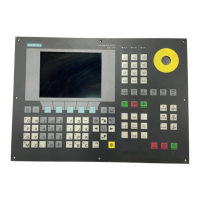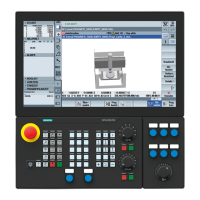Special Motion Commands
4.8 Extended measuring function (MEASA, MEAWA, MEAC) (option)
Job planning
270 Programming Manual, 07/2010, 6FC5398-2BP40-0BA0
Measurement job with two measuring systems
If a measuring job is executed by two measuring systems, each of the two possible trigger
events of both measuring systems of the relevant axis is acquired. The assignment of the
reserved variables is therefore preset:
$AA_MM1[<axis>]
or
$AA_MW1[<axis>]
Measured value from measuring
system 1 on trigger event 1
$AA_MM2[<axis>]
or
$AA_MW2[<axis>]
Measured value from measuring
system 2 on trigger event 1
$AA_MM3[<axis>]
or
$AA_MW3[<axis>]
Measured value from measuring
system 1 on trigger event 2
$AA_MM4[<axis>]
or
$AA_MW4[<axis>]
Measured value from measuring
system 2 on trigger event 2
Probe status
The probe status is available in the following system variables:
$A_PROBE[<n>]
<n>=probe
Value Significance
1 Probe deflected
0 Probe not deflected
Measuring job status for MEASA, MEAWA
If an evaluation is required in the program, the measuring task status can be checked via
$AC_MEA[n], where <n> = number of probe. Once all the trigger events of probe <n> that
are programmed in a block have occurred, this variable returns a value of "1". Otherwise, its
value is 0.
Note
If measurement is started from synchronized actions, $AC_MEA is no longer updated. In this
case, new PLC status signals DB31, … DBX62.3 or the equivalent variable
$AA_MEAACT[<axis>] must be checked.
Meaning:
$AA_MEAACT==1: Measurement active
$AA_MEAACT==0: Measurement not active
Continuous measurement (MEAC)
The measured values for
MEAC are available in the machine coordinate system and stored in
the programmed FIFO[n] memory (circular buffer). If two probes are configured for the
measurement, the measured values of the second probe are stored separately in the
FIFO[n+1] memory configured especially for this purpose (defined in machine data).
The FIFO memory is a circular buffer in which measured values are written to $AC_FIFO
variables according to the circular principle, see the chapter titled "Motion-synchronous
actions".

